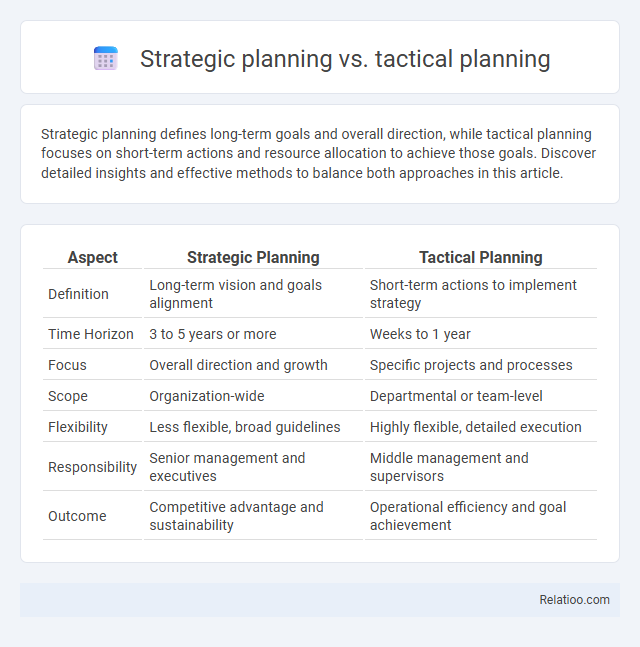Strategic planning defines long-term goals and overall direction, while tactical planning focuses on short-term actions and resource allocation to achieve those goals. Discover detailed insights and effective methods to balance both approaches in this article.
Table of Comparison
| Aspect | Strategic Planning | Tactical Planning |
|---|---|---|
| Definition | Long-term vision and goals alignment | Short-term actions to implement strategy |
| Time Horizon | 3 to 5 years or more | Weeks to 1 year |
| Focus | Overall direction and growth | Specific projects and processes |
| Scope | Organization-wide | Departmental or team-level |
| Flexibility | Less flexible, broad guidelines | Highly flexible, detailed execution |
| Responsibility | Senior management and executives | Middle management and supervisors |
| Outcome | Competitive advantage and sustainability | Operational efficiency and goal achievement |
Introduction to Strategic and Tactical Planning
Strategic planning defines the overarching goals and direction of an organization, aligning resources to achieve long-term vision and competitive advantage. Tactical planning breaks down these strategic goals into actionable short-term initiatives, focusing on specific tasks and deadlines to optimize operational efficiency. Understanding the distinction between strategic and tactical planning is crucial for effective management, ensuring coherent execution from high-level objectives to day-to-day activities.
Defining Strategic Planning
Strategic planning involves setting long-term goals that guide Your organization's overall direction by analyzing internal capabilities and external market conditions. It defines the roadmap for achieving competitive advantage through resource allocation and priority setting across multiple business units. Unlike tactical planning focused on short-term actions or long-term vision that outlines overarching aspirations, strategic planning bridges these elements by creating actionable, data-driven strategies aligned with Your company's mission.
Defining Tactical Planning
Tactical planning breaks down your long-term vision and strategic planning into actionable, short-term steps that drive immediate progress toward specific objectives. It focuses on allocating resources, setting deadlines, and assigning responsibilities to ensure efficient execution and measurable results. Understanding tactical planning empowers you to bridge the gap between high-level goals and daily operations effectively.
Key Differences Between Strategic and Tactical Planning
Strategic planning focuses on defining your organization's long-term vision, goals, and overall direction, setting the foundation for sustained growth and competitive advantage. Tactical planning breaks down the strategic plan into actionable, short-term initiatives and resource allocations to achieve specific objectives within defined timeframes. Understanding the key differences reveals that strategic planning centers on "what" and "why," while tactical planning addresses "how" and "when," ensuring alignment between your vision and daily operations.
Importance of Strategic Planning in Organizations
Strategic planning lays the foundation for your organization's success by setting clear priorities, defining long-term goals, and allocating resources effectively to achieve sustainable growth. Unlike tactical planning, which focuses on short-term actions, and long-term vision, which describes the desired future state, strategic planning bridges these elements by creating actionable roadmaps aligned with the company's mission and market dynamics. Emphasizing strategic planning ensures your organization remains adaptable, competitive, and focused on measurable outcomes amid evolving business environments.
Importance of Tactical Planning for Operational Success
Tactical planning bridges the gap between your long-term vision and daily operations by outlining specific actions and resource allocations essential for achieving immediate goals. Its importance lies in translating strategic goals into executable steps that ensure operational success and maintain organizational agility. Effective tactical planning enables your team to respond to challenges swiftly while keeping progress aligned with overarching strategic objectives.
How Strategic and Tactical Plans Interact
Strategic planning defines overarching goals and priorities, setting the framework for actionable steps within an organization's long-term vision. Tactical planning translates these strategic objectives into specific, short-term tasks and resource allocations, ensuring operational alignment with broader ambitions. The interaction between strategic and tactical plans facilitates cohesive decision-making, enabling continuous progress toward long-term success while adapting to immediate challenges.
Examples of Strategic vs Tactical Planning
Strategic planning involves setting broad, long-term goals such as expanding into new markets or developing innovative products, while tactical planning focuses on specific actions like launching a marketing campaign or optimizing supply chain processes to achieve those goals. For example, a strategic plan may prioritize entering the European market within five years, whereas a tactical plan will detail quarterly sales targets and local partnerships to support that expansion. Your business benefits by aligning tactical plans as concrete steps that execute the overarching strategic vision, ensuring measurable progress towards long-term success.
Common Pitfalls in Strategic and Tactical Planning
Common pitfalls in strategic planning include setting unrealistic goals, lack of alignment with organizational capabilities, and insufficient stakeholder engagement, leading to ineffective execution. Tactical planning often suffers from poor prioritization, neglecting resource constraints, and failing to monitor progress, which hampers achieving short-term objectives. Misalignment between strategic and tactical plans can undermine long-term vision, causing fragmented efforts and missed opportunities for sustainable growth.
Best Practices for Integrating Strategic and Tactical Planning
Integrating strategic and tactical planning requires aligning high-level organizational goals with actionable, short-term initiatives to ensure cohesive execution and measurable outcomes. Best practices include establishing clear communication channels between strategy developers and operational teams, using performance metrics to track progress, and regularly reviewing plans to adjust tactics based on evolving market conditions. Leveraging technology platforms for real-time data sharing and fostering a culture of agility enhances the connection between a long-term vision and day-to-day operations.

Infographic: Strategic planning vs Tactical planning
 relatioo.com
relatioo.com